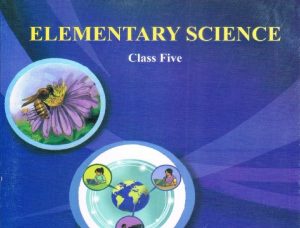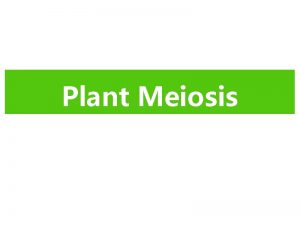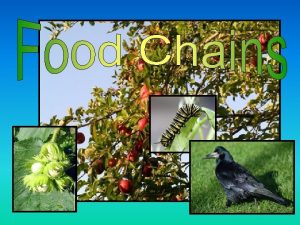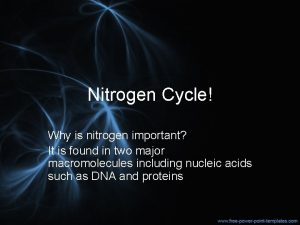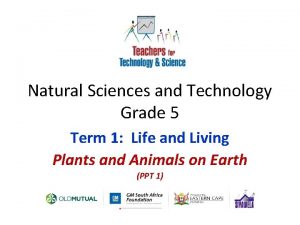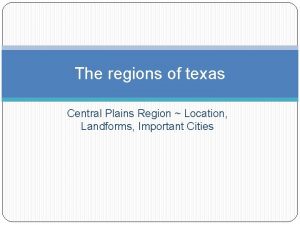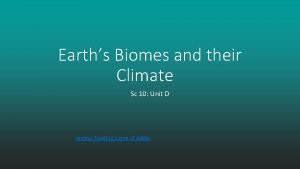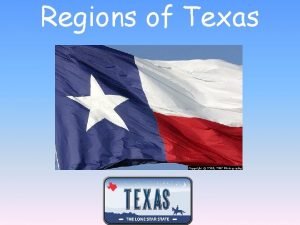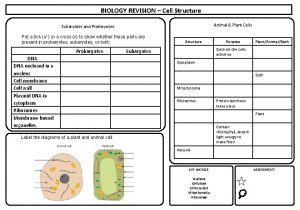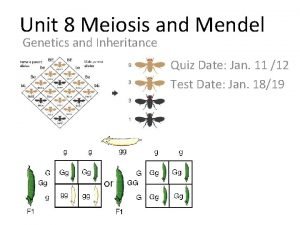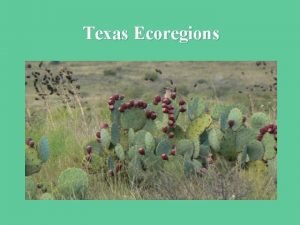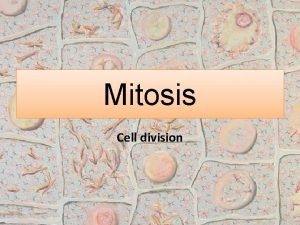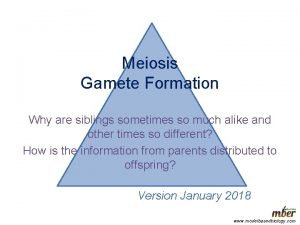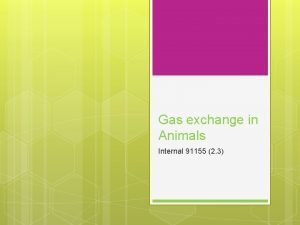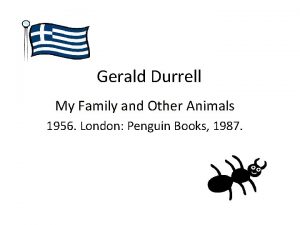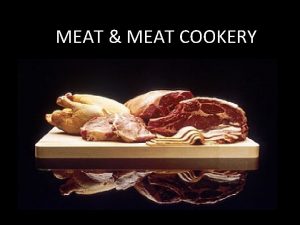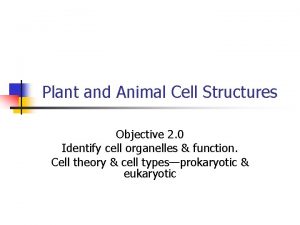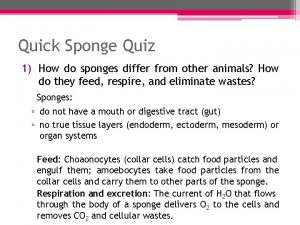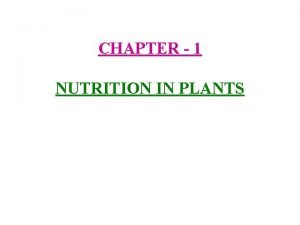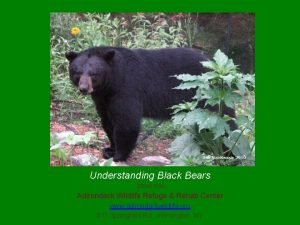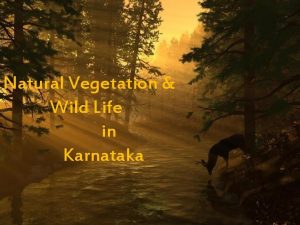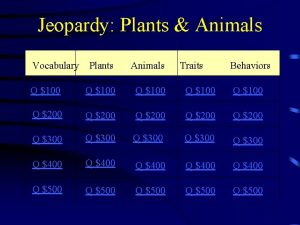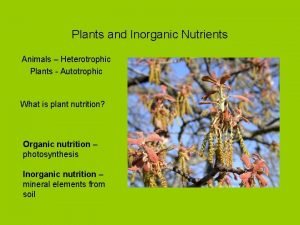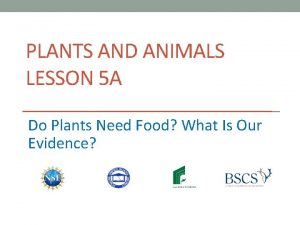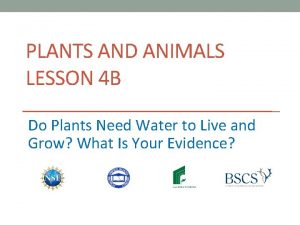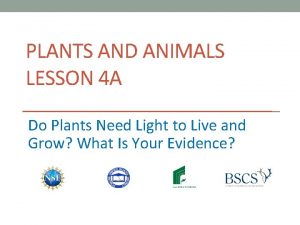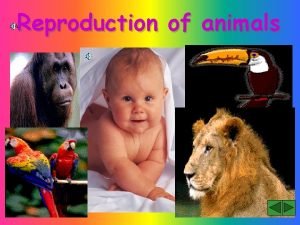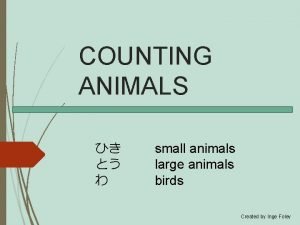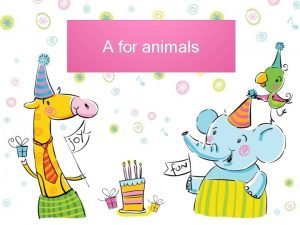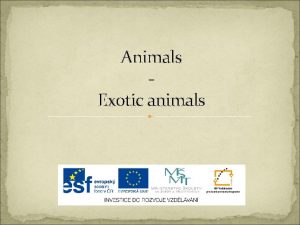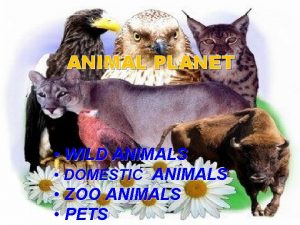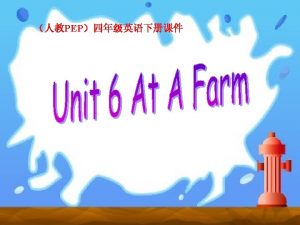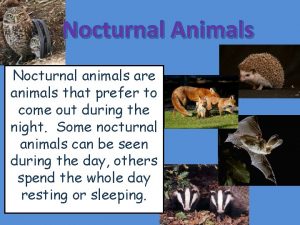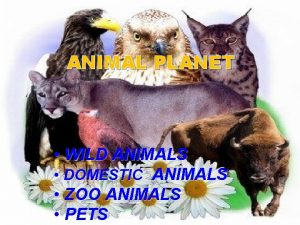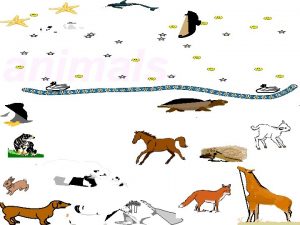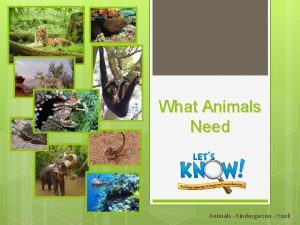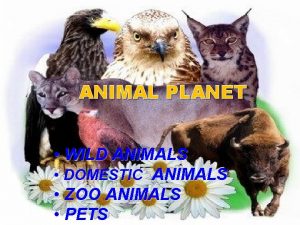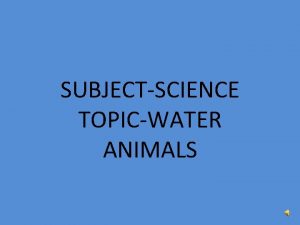Wildlife Wildlife refers to plants animals and other

































- Slides: 33

Wildlife

Wildlife refers to plants, animals, and other living things that have not been domesticated. Domestication is the process of bringing living things under the control of humans. Animals are usually the first thing we think of when we hear the word wildlife. However, plants and other living things are also a part of wildlife.

A. A wildlife animal is an animal that has not been domesticated. Wildlife animals include bears, deer, rabbits, squirrels, and many others. 1. Domesticated animals, like dogs, cats, horses, and cows, are tame animals that are kept and bred in captivity by humans who provide for all their needs. 2. Wildlife animals are free to roam the land, water, or air.

3. Wildlife animals live on their own. They must depend upon their own actions for survival. They must find their own food, water, and shelter. 4. Protection from predators and the elements is critical to the survival of wildlife animals. 5. Wildlife animals must compete to survive among many different species of animals. 6. Wild animals in zoos are not domesticated. They still retain much of their natural behavior.


B. A wildlife plant is a plant that has not been domesticated. 1. Many plant species are considered to be wild. Think about the wildflowers that are found along roadsides and in parks. 2. Wildlife plants include a variety of grasses, vines, flowers, shrubs, and trees. 3. Wildlife plants can be found on land or in water. 4. Wildlife plants grow on their own without any effort from us.


An ecosystem is a self-contained living system. John Muir, a noted conservationist of the 1800 s, said, “When we try to pick out anything by itself, we find it hitched to everything else in the universe. ” In this statement he was emphasizing that all living things are both interrelated and interdependent. These connections of living organisms and nonliving organisms within a particular environment make up an ecosystem.

All things depend upon one another in some way to survive. 1. Ecology is the branch of science that deals with the relationships living things have to each other and to their environment. 2. An ecosystem contains communities made up of populations. A population is all of the organisms that live in a given area. A community is a group of interacting populations living together in the same environment.

� 3. Communities are affected by the land, water, climate, and the species living in the community. The species in a community include both plants and animals, including humans. Human activity can be helpful or harmful depending on what is done. �a. For instance, if trees are cleared from a piece of land for development, it may be harmful to the wildlife. �b. On the other hand, if more trees and prairie grasses are planted in an area it may establish a habitat for wildlife.

A food chain is the sequence in which living things in a community get their food. A food chain shows how energy is passed from one life form to another. 1. The food chain begins with natural resources—sun, water, air, and soil. These resources provide what plants need to grow, produce their own food, and reproduce. As plants grow, some energy is stored in their leaves, stems, fruit, seeds, and roots. 2. When other living creatures eat the plants, the energy is passed along the chain to the animal. Animals also store energy in their bodies.



3. Stored energy from animals is passed along the food chain when another animal eats them. An animal that hunts, kills, and eats other animals is called a predator. 4. When an animal or plant dies, it either decomposes or is eaten by a scavenger. A scavenger is an animal that usually eats dead animals and rarely kills its own prey. 5. When something decomposes, it is broken down into smaller parts as it returns to the earth. The food chain cycle then begins again.

A food web is a way of showing how food chains in a community are connected. It also shows how all food begin with resources, such as sunlight and water. Animals in the food web are classified into groups based on the types of food they consume.

1. A herbivore is an animal that eats only plants for food.

2. A carnivore is an animal that eats only other animals for food.

3. An omnivore is an animal that eats both plants and animals for food

Because all parts of an ecosystem are connected, changes in one area of the ecosystem can have an effect on all of the things in the entire ecosystem. 1. Changes occur all of the time in an ecosystem. 2. Changes may happen daily, seasonally, or over a period of years. 3. Ecosystems generally find a way to stay as balanced as possible. 4. Natural events, such as floods, droughts, fires, tornados, or hurricanes, can cause major changes to take place in an ecosystem. 5. People can also force changes to occur in an ecosystem. 6. Because everything is connected, when one thing changes it affects something else, that affects something else, which in turn affects something else, and so on.

A habitat is the physical area in which a wildlife species lives in natural conditions. Many things make up a habitat: climate (temperature, rain, etc. ), the lay of the land, the nature of the soil and water, and other plants and animals in the area. Life’s most fundamental necessities— food, water, shelter, and space—in a suitable arrangement must be available in a habitat. Without these basic components, organisms cannot survive.

Food is necessary in a habitat to sustain life. 1. The food that animals eat provides all the nutrients they need to live, grow, move, and reproduce. 2. The food available in a habitat varies throughout the year with the changing seasons.

Another basic need for all living things is water. 1. Habitats have to have an ample, clean supply of water to support the wildlife living there. 2. Animals may obtain water directly by drinking or indirectly through the foods they eat.

Shelter or cover is the vegetation or other material needed in a habitat to protect the species living there. 1. Different species require different amounts of shelter during certain stages of their development, such as during the reproductive season, during hibernation, or during molting. 2. Wildlife animals depend on cover to conceal themselves from predators as they move about. 3. Animals also need cover to help protect them from the weather. 4. Shelter is also needed while resting, sleeping, or nesting.

A habitat must also provide space. Space is the area or territory around an organism. It is used by the organism for living. 1. Space provides air, food sources, and cover. 2. Space requirements vary by species, season of the year, and quality of the habitat.


There are many different types of habitat. Habitats can be identified by soil type, how much water is present, the climate, or the major type of plant species in the area. Habitats can be land, water, or both. Terrestrial wildlife live on land. Aquatic wildlife live in water.

Prairies are grasslands that have no trees at all or widely scattered trees. 1. Prairies can be found all over the world. 2. About 32 to 40 percent of the world’s land is or was covered by grasslands. 3. In North America, prairies cover 15 percent of the land surface.

�B. Forests can be divided into deciduous forests and rainforests. � 1. Deciduous forests contain mostly plants that periodically (usually in the fall of the year) lose all their leaves. � 2. Rainforests are forests that receive more than 80 inches of rain per year. Rainforests grow in more than 50 countries. Although we often think of the tropical rainforests along the equator, there are others. �a. Temperate rainforests are found in the U. S. Pacific Northwest. �b. Flooded mangrove forests are found along the salty coastlines of the Southeast Asian Islands. �c. High altitude cloud forests are found in South America.

C. Deserts areas that receive very little or no rainfall. The temperatures in a desert range from very hot to cold.

D. Wetlands areas that periodically have standing water or waterlogged soils. Swamps, marshes, and bogs are types of wetlands.

E. Oceans are large salty bodies of water that cover 75 percent of the earth’s surface.

F. Lakes and ponds are natural or artificial reservoirs that hold water. 1. Most lakes and ponds have freshwater. 2. Some lakes and ponds have saltwater. 3. Water temperature in lakes and ponds varies with the surrounding climate and the source of the water.

G. Streams are bodies of flowing water that move from higher to lower elevations. Stream size varies. Creeks are small streams; rivers, such as the Mississippi River, are large streams.
 Producers consumers and decomposers
Producers consumers and decomposers Parasitic food chain
Parasitic food chain Animals that eat both plants and animals
Animals that eat both plants and animals Science class five
Science class five Site of meiosis in plants and animals
Site of meiosis in plants and animals Keystone species definition biology
Keystone species definition biology Cloroplasto
Cloroplasto Sexual and asexual reproduction in animals venn diagram
Sexual and asexual reproduction in animals venn diagram Animals that live in temperate deciduous forests
Animals that live in temperate deciduous forests Every living plants and animals must have
Every living plants and animals must have Ciclo del fosforo
Ciclo del fosforo Plants and animals on earth grade 5
Plants and animals on earth grade 5 Central plains of texas
Central plains of texas Grassland biome animals and plants
Grassland biome animals and plants Subregions of texas
Subregions of texas When does respiration take place in animals and plants?
When does respiration take place in animals and plants? Heterozygous tall
Heterozygous tall Ecoregions in texas
Ecoregions in texas Differences between mitosis in plants and animals
Differences between mitosis in plants and animals Modelbasedbiology
Modelbasedbiology Gas exchange in plants and animals venn diagram
Gas exchange in plants and animals venn diagram Non flowering plants classification
Non flowering plants classification My family and other animals characters
My family and other animals characters Kyle douglass
Kyle douglass It refers to the edible flesh of animals
It refers to the edible flesh of animals What are organelles
What are organelles Vascular vs nonvascular plants
Vascular vs nonvascular plants Non vascular plants
Non vascular plants C3 plant
C3 plant How do sponges differ from other animals
How do sponges differ from other animals Slidetodoc. com
Slidetodoc. com Self initiated other repair examples
Self initiated other repair examples Adk wildlife refuge
Adk wildlife refuge Vegetation
Vegetation



